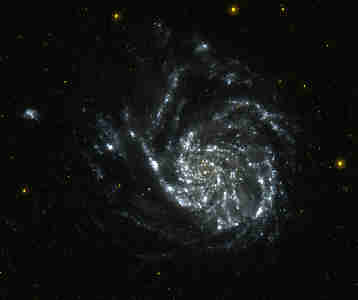
Back to the Space Place Index
So Little Time,
So Many Galaxies
By
Dr. Tony
Phillips
Fourteen billion years ago, just after the Big Bang,
the universe
was an expanding fireball, white hot and nearly uniform. All of
space was filled with elementary particles and radiation.
"Soupy" is how some cosmologists describe it.
Today the universe is completely different. It's still
expanding-even accelerating-but there the resemblance ends. The
universe we live in now is "lumpy." Great cold voids are sprinkled
with glowing galaxies. In galaxies, there are stars.
Around stars, there are planets. On one planet, at
least, there
is life.
How we got from there to here is a mystery.
Finding out is the goal the Galaxy Evolution Explorer, "GALEX" for
short, a small NASA spacecraft launched into Earth orbit
April 28,
2003. GALEX carries an ultraviolet (UV) telescope for
studying
galaxies as far away as 10 billion light-years.
"GALEX is a time machine," says astronomer Peter Friedman
of
Caltech. Because light takes time to travel from place to place,
pictures of distant galaxies reveal them as they were in
the past.
"GALEX is investigating the evolution of galaxies over 80%
of the
history of our universe."
The Hubble Space Telescope can see faraway galaxies, too,
but GALEX
has an advantage: While Hubble looks in great detail at
very small
regions of the sky, GALEX is surveying the entire sky,
cataloging
millions of galaxies during its 2-year mission.
GALEX is a UV mission for a reason. Friedman explains: "UV
radiation is a telltale sign of star birth." Stars
are born
when knots of gas condense in interstellar clouds. The ones we see
best are the big ones-massive stars that burn hot and emit lots of
UV radiation. "These stars are short-lived, so they trace
recent star formation."
Understanding star formation is crucial to studies of galaxy
evolution. When galaxies collide, star formation surges.
When
galaxies run out of interstellar gas, star formation wanes.
In
galaxies like the Milky Way, spiral arms are outlined by
star-forming
clouds. The shapes of galaxies, their history and fate =8A
they're all connected by star formation.
Even life hinges on star formation, because stars make heavy elements
for planets and organic molecules.
"Our measurements of UV radiation will tell us both the
rate at
which stars are forming in galaxies and the distances of
the
galaxies," says Friedman.
How did we get here? GALEX will show the way.
Find out more about GALEX at www.galex.caltech.edu. For
children, visit The Space Place at spaceplace.nasa.gov/galex_make1.htm
and make a beautiful galactic mobile while learning about
some of the
different shapes galaxies can take.
This
article was provided by the Jet Propulsion Laboratory, California
Institute of Technology, under a contract with the National
Aeronautics and Space Administration.

This image of Messier 101 (M101), aka the "Pinwheel Galaxy,"
was taken in two orbits of GALEX on June 20, 2003. M101 is 20
million light years away.
|
About LUNAR |
Home |
Calendar |
Contacts |
Old Gallery |
Member Pages |
Events |
Presentations & Docs |
LUNAR'clips |
Handbook |
Space Place |
Mailing Lists |
Joining |
Other Rocketry Pages |
Site Map |
Frames |
All content is the responsibility of LUNAR.
If you have comments or suggestions regarding these web pages,
please contact the 
Copyright © 1992 - 2025 LUNAR



